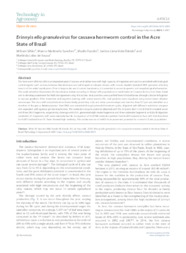Erinnyis ello granulovirus for cassava hornworm control in the Acre State of Brazil.
Erinnyis ello granulovirus for cassava hornworm control in the Acre State of Brazil.
Autoria: SIHLER, W.; SANCHES, M. M.; FAZOLIN, M.; ESTRELA, J. L. V.; SOUZA, M. L. de
Resumo: The hornworm (Erinnyis ello) is an important pest of cassava and rubber tree with high capacity of migration and can be controlled with biological control agents such as baculoviruses. Baculoviruses are rod-shaped enveloped viruses with circular double-stranded DNA genomes infecting insects of the order Lepidoptera. Prior to large-scale use of certain baculovirus, it is essential to assess its genetic and morphological information. This work aimed to characterize the baculovirus isolate occurring in Erinnyis ello populations at small farms in Cruzeiro do Sul, Acre State, Brazil and to develop parameters for field management using this isolate. Viral particles were purified from infected larvae through ultracentrifugation in sucrose gradient. After treatment and negative staining with uranyl acetate 2%, viral particles were visualized using transmission electron microscope. The virus with ovicylindrical occlusion body presenting only one virion per envelope and size less than 0.5 µm was identified as a member of the genus Betabaculovirus. Viral DNA was extracted through phenol/chloroform cycles, digested with different restriction enzymes and separated with agarose gel electrophoresis. The restriction enzyme patterns obtained with the enzymes Bam HI and Hind III revealed seven and three DNA fragments, respectively; cleavage with Pst I, generated eight molar fragments and three submolar fragments and Eco RI digestion resulted in 21 fragments, with some submolar bands. Comparison of the DNA restriction pattern from ErelGV isolated in Acre with that described for ErelGV isolated from SC State showed high similarity. This isolate named as ErelGV-Acre presented potential for control of E. ello populations.
Ano de publicação: 2024
Tipo de publicação: Artigo de periódico
Unidade: Embrapa Gado de Corte
Palavras-chave: Acre, Amazonia Occidental, Amazônia Ocidental, Baculoviridae, Baculovirus, Biological control, Cassava, Caterpillar, Comunidades rurales, Control biológico, Controle Biológico, Cruzeiro do Sul (AC), Cultivo a pequeña escala, DsDNA viruses, Erinnyis Ello, Hevea Brasiliensis, Hornworm, Insect larvae, Lagarta, Lepidoptera, Mandioca, Manihot Esculenta, Pequeno Produtor, Pest management, Plagas de plantas, Plant pests, Praga de Planta, Propriedade Rural, Rubber tree, Rural communities, Seringueira, Small-scale farming, Western Amazon, Yuca, x, Árbol de goma
Observações
1 - Por padrão são exibidas publicações dos últimos 20 anos. Para encontrar publicações mais antigas, configure o filtro ano de publicação, colocando o ano a partir do qual você deseja encontrar publicações. O filtro está na coluna da esquerda na busca acima.
2 - Para ler algumas publicações da Embrapa (apenas as que estão em formato ePub), é necessário ter, no celular ou computador, um desses softwares gratuitos. Sistemas Android: Google Play Livros; IOS: iBooks; Windows e Linux: software Calibre.
Acesse outras publicações
Acesse a Base de Dados da Pesquisa Agropecuária (BDPA) para consultar o acervo completo das bibliotecas da Embrapa.

